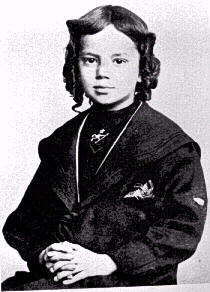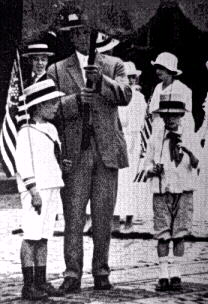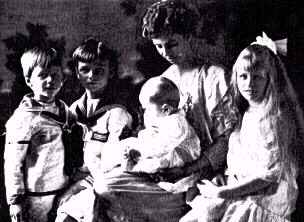Sailor Suits
It was in England in the first
quarter of the century when
someone had the
inspiration that boys should
wear sailors' trousers.
English seamen had been
dressing in pantaloons
since the seventeenth
century and English boys
adopted trousers a half
century before their fathers
did. English children were
the first to be emancipated,
little girls changing to soft,
unlined frocks in the 1770's
with France and the
Colonies following next.
Some well-known writers
had taken the age to task
for its manner of confining
infants' bodies in tight
clothes, among them John
Locke, the English
philosopher (1632-1704),
who was probably the big
influence in the change. He
was followed by Jean
Jacques Rousseau, the
French philosopher
(1712-1775), who carried
on the crusade and was
forced to flee Paris for
England because of his
revolutionary ideas.
Although the change over
to trousers occurred early
in the period, knee
breeches were still worn
for dress as can be seen in
contemporary portraits.
The writings of the Age of
Reason were having an
effect in putting children
into comfortable-clothes, like
skeleton suits or sailor suis. The sailor trouser costume known
as the English sailor's dress
being a short little jacket with an
open-necked blouse,
a waistcoat without skirts
and the long breeches.
British parents in the 19th
Century commonly dressed
children in sailor suits,
especially the boys. The style oncreased in popularity after Queen
Victoria regularly dressed her sons and even daugters in sailor suits. The
style was worn by smaller boys through the 1860s. One fashion magazine, Englishwoman's Domestic Magazine,
in 1861 suggested sailor suits for boys of 6 or 7.
By the 1870s sailor suits were one of the most popular styles for boys up
to 12 or 13 and even older ages on the Continent.
There were several different styles of sailor suits:
- Blue-stripped suit:
- Jersey suit: Knitted jersey's appeared during the 1860s and were
popular at the seaside in the 1880s. One fashion columist in Myra's Journal (1884)wrote, A robust
agile rogue of 6 or 7 never looked so well as when his shapely figure is displayed
by his close-fitting knee breeches and jersey ... being woolen hey keep the body in a due
state of warmth ...on the head is either a Tan-o-shanter or a kind of brewer'd cap ...
of the sanme kind of stockinette as the suit. Jersey suits were often very plain without
all the details on other styles.
- Middy suit:
- Jack Tar suit:
- Man-of War suit: This style was particularly popular
during the early 19th Century. It was more commonly worn with
long trousers than many of the other styles. Usually worn
with a wide-brimmed straw sailor hat.
- Reefer suit:
A complete sailor
suits were made up of a
middy blouse, long or short pants, skirts (for girls and small boys),
and
sailor hat.
Blouse: The blouse had a deep square flat collar and "V"-shaped
neck opening in front showing the vest or dicky.
Pants/skirt: Boys in the Victorian
era wore either long or
short pants with their middy blouse, however, by
 the Edwardian period knee-length pants were almost universal. Smaller boys might wear a modified kilt-like sailor suit with a regulation
middly v\blouse worn with a white or blue kilt-like skirt. Girls and
younger boys wore skirts/kilts.
the Edwardian period knee-length pants were almost universal. Smaller boys might wear a modified kilt-like sailor suit with a regulation
middly v\blouse worn with a white or blue kilt-like skirt. Girls and
younger boys wore skirts/kilts.
Hats: Several differeny styles of hats were worn, determined
by the style of suit chosen and the whims of the mother. Some of the most common in the 19th Century were
broad brimmed sailor hats. English boys also wore the flat topped cap cloth cap worn by
more modern British sailors, also with a ribbon dangling at the back. French and German boys wore the caps worn by the sailors
in their navy.
The boys generally
preferred sailor suits to
other alternatives such as
kilts and Fautleroy suits.
One fashion colunist writing in The Lady's World (1887) indicated that A boy
before he rises to the dignity of trousers and jackets is never as happy as in a Middy suit
or Jack Tar, and these suits are now selling in thousands.
The style became very
popular in America and
many European countries,
especially Germany and
Italy where they were
mostly worn with short
pants.
The sailor suit was one of the most popular fashions of the end of the
19th century for
 both boys and girls. Boys wore the tunic with long pantaloons or increasingly
popular straight knee pants. After the turn of the century shorts
appeared, but until after the First Wrl War (1918) continued to be rather long.
Girls wore the tunic with the kilted skirt. The suits were made in
blue or white serge for winter and of French flannel, linen or duck
for summer.
both boys and girls. Boys wore the tunic with long pantaloons or increasingly
popular straight knee pants. After the turn of the century shorts
appeared, but until after the First Wrl War (1918) continued to be rather long.
Girls wore the tunic with the kilted skirt. The suits were made in
blue or white serge for winter and of French flannel, linen or duck
for summer.
Boys continued to commonly wear
sailor suits in Europe and
America through the 1920s and 30s. Quite old boys wore saiolor suits on the comtinent
during the 1920s and 30s, often with short pants. This was
particularly true in Germany. British boys generally didn't wear
sailor suits commonly after 8 or 9. This was because boys from
affluent families generally were sent off to boarding school at
about 8 years of age. These boys generally did not want to wear
sailor suits as they would be teased by the oyher boys. Instead they
tended to wear their school uniforms.
In both America and
Britain by the 1940s, only
younger boys were
 dressed in sailor suits. The fashion for older boys eventually passed out of fashion on the continent
after World War II (1945). Uniforms in general passed out of favor in Germany as well as
other countries.
dressed in sailor suits. The fashion for older boys eventually passed out of fashion on the continent
after World War II (1945). Uniforms in general passed out of favor in Germany as well as
other countries.
The styles and materials for
the middy blouse varied
greatly. Authentic ones
included three white stripes
for Nelson's three great
victories. Sailor suits were
generally blue or white,
worn with maching
stckings. The white suits
were generally worn during
the summer.
 the Edwardian period knee-length pants were almost universal. Smaller boys might wear a modified kilt-like sailor suit with a regulation
middly v\blouse worn with a white or blue kilt-like skirt. Girls and
younger boys wore skirts/kilts.
the Edwardian period knee-length pants were almost universal. Smaller boys might wear a modified kilt-like sailor suit with a regulation
middly v\blouse worn with a white or blue kilt-like skirt. Girls and
younger boys wore skirts/kilts.
 both boys and girls. Boys wore the tunic with long pantaloons or increasingly
popular straight knee pants. After the turn of the century shorts
appeared, but until after the First Wrl War (1918) continued to be rather long.
Girls wore the tunic with the kilted skirt. The suits were made in
blue or white serge for winter and of French flannel, linen or duck
for summer.
both boys and girls. Boys wore the tunic with long pantaloons or increasingly
popular straight knee pants. After the turn of the century shorts
appeared, but until after the First Wrl War (1918) continued to be rather long.
Girls wore the tunic with the kilted skirt. The suits were made in
blue or white serge for winter and of French flannel, linen or duck
for summer.
 dressed in sailor suits. The fashion for older boys eventually passed out of fashion on the continent
after World War II (1945). Uniforms in general passed out of favor in Germany as well as
other countries.
dressed in sailor suits. The fashion for older boys eventually passed out of fashion on the continent
after World War II (1945). Uniforms in general passed out of favor in Germany as well as
other countries.